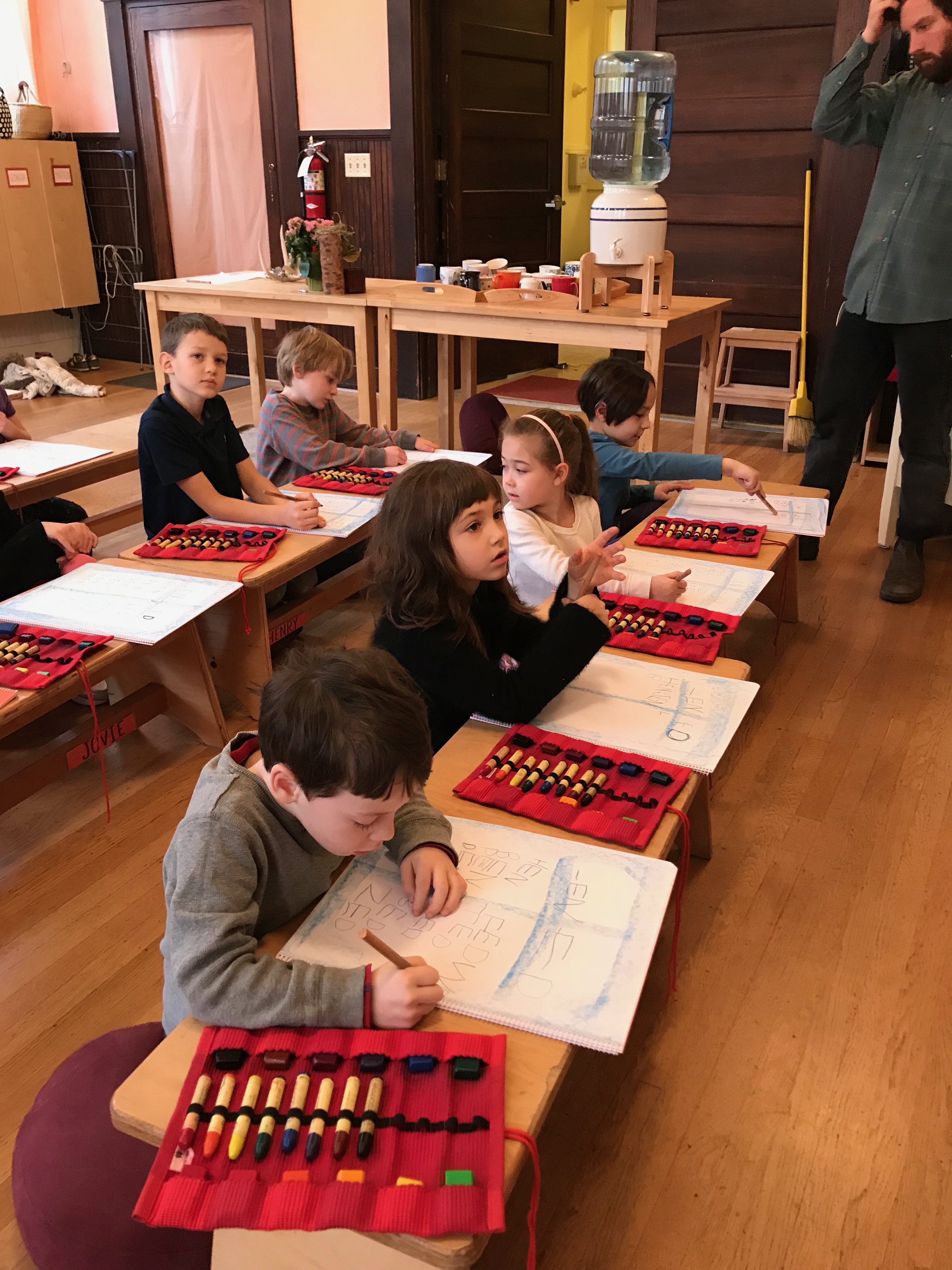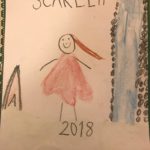I can’t quite believe our magical first grade year has come to a close. I can’t tell you how much I have enjoyed teaching Waldorf first grade.

Over the course of the past few weeks, the first graders and I have gradually prepared ourselves for second grade. We’ve moved into our new classroom, we stitched all of our first grade books together and we completed self-portraits. Our graduating 8th grade teacher started this practice with her students way back when and at graduation she had quite a collection of portraits. I’m excited to start the tradition myself. Here’s a selection of some of them. I put these drawings on the front of their main lesson books and covered them with contact paper. It made a really nice finished product.
Yes, first grade has been amazing, and I would call my transformation from middle school teacher to lower grades teacher complete.
There are a few things I’ve learned along the way, and now that school is out, I feel like I can reflect a little bit on the experience and share those little nuggets of wisdom with you here.
You might call this
A Middle School Teacher’s Guide to Teaching First Grade.
Slow down.
It’s mind-boggling how long things can take. Things go SO much more smoothly when you take the time to think through the details and give thorough instructions for every aspect of the work. I think this is especially true for a large class, but I also think setting things up with a lot of clarity is just good teaching. How will the students hand out their supplies? How will they move through the room? How will they line up for recess? How will they transition from one class to another? Where are your bathroom breaks? How should they put away their supplies?

Every one of these steps is a process that needs to be taught. I took a lot of time at the beginning of the year to teach my students these protocols (inspired a lot by a Responsive Classroom book I love called The First Six Weeks of School) and it really paid off. This, of course, meant that we didn’t get through a lot of material at the beginning of the year — learning how to be in a classroom was the content, but it was definitely worth it. And the slow pace that we started with set the tone for the year, which interrupted my middle school teaching habits.
Don’t be afraid to luxuriate in the slow pace. There’s no need to pack your lessons full. Our days were so much smoother if we had either a story or bookwork, and the days I tried to do both felt rushed.
Find silence.
All of that direct instruction can be exhausting, and I sometimes felt that my voice was a constant stream that held the space. As long as I was talking, students would not interrupt. There were times I needed to remind myself to teach the students to allow for silence. Years ago, I observed that there are really two ways to manage students.
- Engagement with the material. Keep them busy and working and interested in the content and there just won’t be time for them to talk or get distracted.
- Directly teach them patience and to allow for silent pauses throughout the day.
My teacher training definitely focused on the first way of managing a classroom. And truly, one of the gifts of Waldorf Education is that the material is especially chosen, prepared and crafted to be completely engaging to the students at their specific stage of development. Keeping your students engaged and occupied is a healthy aspect of a classroom management approach.

But, keeping them engaged can’t be your only strategy.
For my first few years of teaching, I managed my students exclusively through engagement. I felt that if they were calling out or talking with one another, the problem was that I hadn’t done my job in making the content interesting enough. The more they talked, the more I turned up the fire on my lesson prep. And then, when I was actively teaching, I Didn’t. Stop. Talking. I worried that if I had to stop to collect my thoughts or retrieve my lesson book from my desk, I would lose the students, they would start talking and all would be lost.
By the end of every lesson I was breathless.
Ever since, I have very deliberately taught my students how to allow for silence, whether it is to let me find my place in my notes, work individually with a student, or to simply have a silent working time. Those moments of silence are essential and, I think, a valuable part of human existence that is getting lost in the busy-ness of our modern world.
First Grade Skills
Are you tracking your students' skills? Report-writing time will be here before you know it. Start tracking those skills with this handy form.
Be conscious of your voice.
To me, this goes along with the importance of silence, but brings an added layer. It’s so easy to get swept up in the activity of the day as you guide and respond to your students, it is sometimes hard to slow down enough to remember to pay attention to how you are using your voice. For me this comes down to two key reminders.
- Find strategies for avoiding using your voice.
- Don’t get in the habit of repeating yourself.
First, there are plenty of ways you can give instructions to your students without using your voice. Here’s a quick list that comes right to mind. . .
- Start singing a song that indicates what the students should do next. (Yes, you’re using your voice, but the students will take over and you can drop off.)
- Use a glockenspiel with different melodies that indicate instructions. (I did this throughout the year with the various positions we used with our movable classroom. You can read about it here.)
- Use the power of pantomime. It’s astonishing how silent the class will become when they see you are acting out the daily schedule or what they should wear to recess.
- Use signs or drawings as indicators. For example, I’ve seen teachers put up little drawings to indicate recess attire or have a movable arrow to show the level of noise acceptable in the room.
- Teach the students that when you move to a different part of the room, a behavior is indicated. For example, when I moved to the side of the room near our supplies, the students knew that it was time to hand them out.
- Establish a strong rhythm. This is the number one key to maintaining a smoothly running classroom that doesn’t require you to give lots and lots of verbal instructions.

Don’t repeat yourself!
The second part of this is not repeating yourself. Man oh man, did I fall down on this one at the end of the year!
Very often, teachers end up repeating themselves because they did not have the class’ attention when they first gave the instruction. By the end of the year, I was hollering instructions to groups of students who were busy getting ready for recess, hoping that at least a few would hear and respond. Of course, I ended up repeating myself, and worse, getting frustrated when they didn’t do what I had instructed.
Years ago, my sister told me about a parenting technique that is a perfect strategy for avoiding this tendency. When she was getting ready to tell her children something important, she made sure she had their attention first. This meant that before giving the instruction, she would say her child’s name and she taught him to respond and make eye contact. Only then, would she give the instruction. If he didn’t follow through then, she knew it wasn’t because he hadn’t heard the instruction. It went like this . . .
“William?”
“Yes, Mommy?” (with eye contact)
Then she would give the instruction.
I have to admit, when I first witnessed it, it felt a little overly-formal for a parent-child relationship. But it sure worked! And when the exchange is held with an attitude of love and understanding, it’s great. After all, without this level of clarity, children can “get in trouble” for not complying with an instruction they either didn’t hear or understand. Doesn’t exactly seem fair, does it?
What does this look like in the classroom?
I worked with something similar in my class. At the beginning of the year, I taught them to respond as a group. When I said, “First grade,” they were to reply, “Yes, Ms. Floyd-Preston.” I was pretty good about using this strategy at the beginning of the year, but lost the habit as the year went on. I’m sure looking forward to bringing it back in 2nd grade!
The other technique I used was to teach them to respond with, “Yes, ma’am!” I have to admit, I find it so satisfying to have a group of students respond to me with these words. There is something about this old-fashioned formal language that made my students sit up straighter and work together like a highly-trained group of soldiers. Often it was when I asked, “Did you hear me?” or instructed “Stand up straight,” that they replied with a sharp, “Yes, ma’am.” I loved it.
I have lots of other bits of wisdom gained after a year in first grade, but I’ll save them for another post.
First Grade Skills
Are you tracking your students' skills? Report-writing time will be here before you know it. Start tracking those skills with this handy form.












Leave a Reply